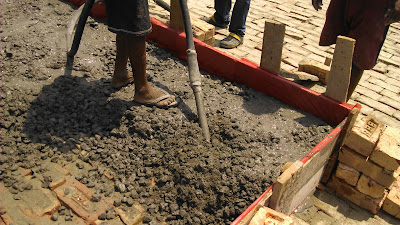Today I will discuss about importance of water in concrete at different stages of it . I’ve seen that most of the workers, contractors if not all and some of the Engineers tends to ignore the importance of Water at various stages of concrete. The main reason behind this I think is that they are not aware of the fact that water plays a dramatically important role in concreting operations, as it is a kind of maker or breaker. Also students tends to take the matter lightly, but they must understand that actually it is a single most important factor which can change the quality of concrete even no matter how much extra cement you put into for the compensating purpose.
 |
| CONCRETING OPERATION – PERFECT COLOUR AND TEXTURE |
Let us first understand when and how water comes in contact with the concrete. The concrete itself is a conglomeration of Water, Binder, Fine Aggregate and Coarse Aggregate. Binder in case of Cement Concrete which one is in use in modern day construction is Cement, which may be of any type like OPC, PPC, PSC etc. as Fine Aggregate generally Sand is used, and as Coarse Aggregate Crushed Stone or Stone Chips is used. Now Water in concrete comes in two different stages,
- During the mixing of the raw ingredients of concrete, that means while producing the Green Concrete.
- Secondly, after the concrete has hardened.
Before going into main course let us first understand few key notes:-
It is the ratio of weight of water to the weight of Cement in a Concrete mix. Suppose we have made 1 cu.m. of Concrete in which 380 kg of cement and 228 kg of Water is used, then the as the above definition states it can be understood that Water-Cement Ratio will be (weight of water/ weight of cement) = (228/380) = 0.60
In simple words, Bleeding means channeling out of water from the concrete to the surface after it is placed, and during this bleeding cement in the form of thin slurry is also dragged out.
Segregation means loosing of homogeneity of mass in green concrete by separating out of the Coarse and Fine aggregate from the Cement-Water Matrix.
It is the process by which the cement particles forms Calcium Silicate Hydrate (C-S-H) from the constituents of cement like C3S, C2S etc. in the presence of water, that is the cement gains Strength gradually in a diminishing rate of strength gaining with the passage of time.
In short Curing is a procedure of preventing the Concrete from getting dried out of moisture.
Now we are ready for learning the whole procedure deeply but without any extra crappy theories, so don’t worry, it is my guarantee that You will understand 100% sure.
 |
| CONCRETING IN LAYERS FOR PERFECT COMPACTION |
Importance of Water during Mixing or Production :-
Hey first you go a little up on the page and read the note on Water-Cement Ratio again, I know you hurriedly read it last time isn’t it?.
So, there was a person named Abram, who made out a law by experiments on Concrete. According to him (which is 100% correct so read carefully) The Strength of a Concrete is Inversely Proportional to the Water-Cement Ratio for a given Temperature and Time, other things being constant. Hummmm, don’t worry I’ll explain it out in much easier way.
The above law states that Strength of Concrete will increase if the Water-Cement Ratio is Decreased and Strength of Concrete will Decrease if the Water-Cement Ratio is Increased. Again in other words, if we need to make a Concrete which will be strong then we must put in less amount of water during mixing of concrete, and if we want a weak concrete then we may increase the water content.
But remember one thing over here, that other things are unchanged, like if you will increase the cement content upto certain limit the strength will definitely increase even if you don’t lower the Water-Cement Ratio.
Now the question is why this happens? Why would you believe in someone’s law no matter who the guy he is without knowing the reason behind that.
The most influencing reasons are occurring of Voids, Bleeding and Segregation of Green Concrete if Water in excess is used. Excess of water will cause Bleeding of Concrete and as the water during the phenomenon of bleeding form small tube like channels within the freshly laid concrete, later on hardening these tubes will remain as voids, similar to like low bone density in humans, they will cause easy braking up of the hardened concrete mass, that means lesser will be strength. If water is used in excess than what is required then is will give fluidity to the green concrete to a higher level that the Cement-Water Matrix will be very thinner and have lesser adhesive power to put together all the ingredients of concrete with homogeneity, as a result segregation will take place, and the concrete will no more remain a concrete due to the separation of Cement Slurry from the Aggregates. It may be compared with the fact that if water is mixed with paper adhesive (gum) the bonding strength is reduced.
But in field, there are numerous problems which may arise due to low water content during mixing, especially in tropical conditions, they are as follows :
- Very Harsh and dry mix is obtained, which cannot be placed easily in between forms and reinforcements.
- Bad Surface is Obtained showing undulated surfaces and too much Stone Chips exposed Surfaces, which becomes very porous to the water in future and causes leakage of water from roof.
The above two situations can easily be tackled, just follow the guidelines below :
- Use of Proper Water-Cement Ratio as per Your National relevant Code
- Use Cement-Water Slurry in the same Water Cement Ratio that of the concrete to wash the internals of the mixing drum before each continuous batch of mixing, so that cement slurry is not absorbed at the actual time of batching to the dry surface of mixing drum.
- Required mix proportions must strictly be maintained.
- Bulkage of sand is to be calculated each day at site before starting the casting operation, and required suitable adjustments are to be made, generally this varies from 18%-33% by Volume.
- Mix all the ingredients atleast for 80 Seconds, the time must be counted from after the last material has been dumped into the mixer. For producing best mixing in Tilting Drum Mixer takes 2 minutes.
- Water up the base and saturate it before commencing of casting operation where the green concrete will be discharged from the mixer directly near the mixer.
- Moistened the Formworks 30 minutes prior to casting so that they do not suck up the initial moisture during the casting operation.
- Always use Black or Green Alkathene Paper on formworks, it not only prevents the moisture from the concrete to escape away, also gives good finishing to the concrete surface, specially to Beams and Roofs.
- Synchronize the whole casting process in such a manner that concrete after discharging from the mixing drum, it is carried and properly placed in the form, and well compacted and surface is finished off within 30-45 minutes.
- Place and compact the Concrete in forms in layers suitably not exceeding 150mm thick each, don’t fill full depth all at once, for an example if a beam of overall depth 450mm is being cast, then it is good to fill the whole beams preferably in three layers i.e. 150mm+150mm+150mm = 450mm in this way concrete will be easily compacted and harshness, honeycombing will be avoided.
If one follows all of the above guidelines one will be able to obtain Workable and Homogeneous Concrete even with strict control of water content.
Importance of Water After Concreting is Done :-
Now after the concrete casting is over, both the initial and final setting is passed, it becomes very necessary to retain the moisture in concrete or to continuously keep the concrete moistened so that the hydration process of the cement within the concrete goes on without any discontinuity.
After casting is over, the freshly laid concrete runs out of water or gets dried due to the followings:
- Water being used up in the Hydration Process of Cement.
- Water is absorbed from the concrete by the wooden Formworks.
- Water evaporates due the effects of Wind and Sun.
Now, for the hydration process to be completed satisfactorily Water around 23% by the weight of Cement is required, i.e. Water-Cement Ratio of 0.23. But practically Water-Cement Ratio is kept much higher so as to give the required flow ability to the concrete. Again due to the above mentioned losses of water from the concrete the amount of water required becomes unavailable, as the whole strength gaining time is much longer and water continuously gets lost at a fairly higher rate. As a result of which the concrete becomes dry from inside and out, and also does not get the water required for completion of the hydration process, so the strength gain also disrupts, and the concrete does not attain the strength for which structural design has been done for, and the structure becomes unsafe.
The concrete increases strength for an indefinite period of time at a decreasing rate. In other words Concrete gains most of the strength within first few days, and then it gets slower and slower with the passage of time. It has been observed that Concrete attains about 50% of its 28 days strength in first 3 Days, and 70%-80% of its 28 days strength in first 7 days, and 100% in 28 days, and is continued indefinitely with gradually slower rate of strength gain.
Most of the initial strength gain is due to the hydration of the fast reacting particles of cement, which are C3S (Tri-Calcium-Silicate), C3S is mostly responsible for first 3-7 days strength, then less reactive C2S (Di-Calcium Silicate) hydration start. Later on the gain of strength of concrete is mostly due to the hydration of C2S.
From the above discussion it can be easily understood that Hydration in the initial stage is much more important than on the later stage, as most of the strength is gained within the first 7 days, therefore it is very much essential and foremost important to keep the concrete hydrated or moistened in this period of time, any drying out of concrete at this stage will cause damage to a level of such an extent that the whole structure may become unfit, and this initial damage cannot be repaired later on by over supplying of water.
The Concrete which has been freshly laid must be treated like a new born baby. A baby in his/her first 6 months are more prone to germs and viruses than later on, that is why that period is very critical for their parents, and they are taken great care of. Similarly Concrete in their initial stage especially within first 14 Days must be taken great care of with no drying out of slab or else it will turn disastrous. Believe it or Not this part of Concreting Operation mostly ignored by 90% of the people.
To cope up with all of these successive scenarios, Curing is to be done. Curing does not essentially mean Watering from outside, everybody mistakenly thinks so. Rather Curing means preventing the Concrete from getting dried, weather by supply the water from outside which is a common practice and restoring the moisture required for hydration process or by stopping the moisture from getting out of the concrete, which can be achieved by applying curing agents to the green concrete surface, this procedure is also known as Membrane Curing.
I hope You enjoyed the article, and now have a clear and good understanding of the Topic. Please do share Link to this article to the fellow Civil Engineers, Colleagues, Friends and in your Circle of People on Social Media, and help me to grow this Website. Wish You All Have A Very Good Day.
Any Comments or Criticism will be highly appreciated.
If you like this Article then I am sure you will like the following well researched articles too, come on check them out also







